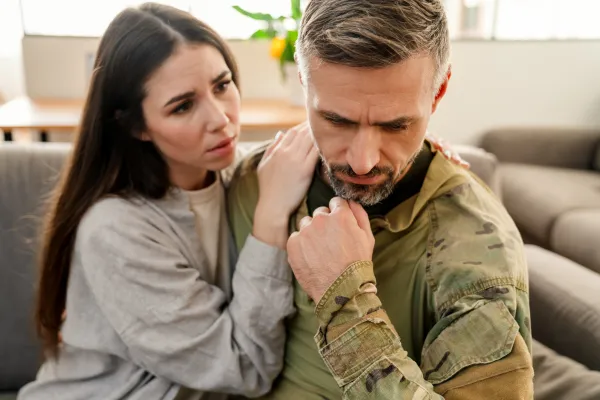

What is Separation Anxiety (and How to Manage It)?
If you’ve ever felt a turning in your stomach when you're away from a loved one, then you might have separation anxiety. Separation anxiety is what we see in children who tearfully cling to their parents at daycare drop-off, afraid to get separated from them. It is also what pets may experience when they are left alone.
These scenarios are common examples of separation anxiety, a condition that can affect people and animals alike. Today, let's define separation anxiety and find out more about how it is different from other anxiety disorders.
What is Separation Anxiety?
According to Medical News Today, separation anxiety is the fear or worry about being apart from a person, a place, or something that provides a sense of security. It is most commonly diagnosed and seen in children, but adults can experience it, too.
When children experience separation anxiety, they can become excessively distressed when parents leave or even have nightmares about separation. Some children may also experience physical symptoms like headache or stomachache.
Adults experience separation anxiety more differently. It might show up as intense worry about loved ones' safety when they're apart or an overwhelming need to stay in constant contact. If not managed, separation anxiety in adults (or even children) can disrupt a normal life.
The Interesting part is that pets can also experience separation anxiety. A dog might bark excessively, chew on furniture, or have accidents indoors when left alone.
How is Separation Anxiety Different from Other Anxiety Disorders?
Anxiety disorders come in many forms, each with unique characteristics. Let’s look at how these other forms of anxiety disorders are different from separation anxiety:
1. Generalized Anxiety Disorder (GAD) – GAD is a chronic anxiety disorder wherein a person is constantly worried about everything in life, like career, love life, family life, work, etc. Unlike separation anxiety, which is specifically triggered by the fear of being apart from a loved one or place, GAD involves a broader range of worries that are not confined to separation.
2. Social Anxiety Disorder – This disorder is characterized by extreme fear of being judged or scrutinized by others. People with social anxiety may avoid public speaking, social gatherings, or even everyday interactions like making phone calls or ordering food at a restaurant. This is rooted in the fear of rejection or embarrassment.
3. Panic Disorder – This is characterized by frequent panic attacks that often happen without warning. When a panic attack happens, the person goes through bouts of intense fear or discomfort. Some of the physical symptoms include difficulty breathing and dizziness. Panic disorder differs from separation anxiety in that the panic attacks can occur without any specific trigger, whereas separation anxiety is directly linked to the fear of separation.
4. Obsessive-Compulsive Disorder (OCD) – Obsession means thinking of something persistently to an extreme degree. Compulsion means doing something over and over. These two combined makes OCD, a disorder that involves unwanted, persistent thoughts (obsessions) and repetitive behaviors (compulsions). While both OCD and separation anxiety can involve significant distress and disruption, the primary difference lies in the nature of the anxiety—OCD is centered around intrusive thoughts and ritualistic behaviors, whereas separation anxiety focuses on the distress caused by separation.
5. Post-Traumatic Stress Disorder (PTSD) – PTSD can develop after exposure to a traumatic event and is characterized by flashbacks, nightmares, and severe anxiety related to the trauma. While separation anxiety can arise from a fear of losing someone due to past traumatic experiences, PTSD involves a broader range of symptoms directly linked to the trauma itself.
How to Manage Separation Anxiety
The strategies in managing separation anxiety for a child will differ from that of an adult. Here are a few:
Children:
Set Up a Routine – Children understand routine. A predictable schedule can help ease their anxiety. When they know what to expect, the fear of the unknown diminishes.
Comfort Objects – A comfort object, such as a favorite toy or blanket, can provide a sense of security when they’re apart from you.
Gradual Separation – Teach children to adapt by practicing gradual separation. Start small to build the child’s confidence then slowly increase the time spent away from the child.
Adults:
Keep In Touch – Doing so will help reduce anxiety. Schedule a regular phone call or video chat and maybe throw in some texts in between.
Take Care of Yourself – Find activities you enjoy and do them. Talk to people who inspire, motivate, and teach you positive things in life. Take a walk. Having a healthy body keeps your mind healthy, too!
Learn to Relax – Try meditation or deep breathing to help manage anxiety.
And don’t forget to reach out for professional support, if you ever need one!
ABOUT US

Jeanne Prinzivalli
Therapist + Coach
I help ambitious, anxious women learn how to trust and put themselves first, so they can stop burning themselves out trying to meet other people's expectations.
SELF CARE CONTINUUM
CLIENT LINKS
LET'S CONNECT
Let’s get you started on relief from self-sabotaging patterns so you can move forward with your life and career passions.
Self Care Continuum Copyright © 2023.




